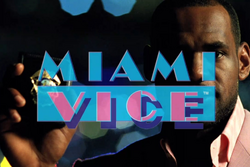
The "Miami Vice" segment of Nike's 2010 advertisement
The Influence of Miami Vice has been so great that it is today considered amongst the most influential television series ever made in history, and many aspects of the show have become pop culture icons. Many of its concepts and techniques, such as its heavy integration of contemporary music and its cinematic filming style, have become standard in modern TV shows, while the series' fashion design had a direct influence on the lifestyle choices of the time.
Influence on Music[]
The music used in the television series was initially merely the result of creative decisions made by the production team, but with the immense popularity of the show (and the proven impact of scenes featuring contemporary tracks, highlighted by the reception given to the "In the Air Tonight" scene), the process soon became influenced by record companies eager to have their artists featured on the show.
The popularity of the music used led to the release of three soundtrack albums, Miami Vice, Miami Vice II and Miami Vice III, the first of which was a huge success and reached #1 on the Billboard Top 200 Album Chart. Musicians would clamour to have their songs used in the series, occasionally arranging with the production team to have a new track appear ahead of its commercial release, hoping to increase interest. The situation reached a point where some acts would compose and record tracks especially for use on the show. Often these songs were featured exclusively in the episodes in which they were used and on the associated soundtrack albums. "You Belong to the City" by Glenn Frey, "When the Rain Comes Down" by Andy Taylor and "Help Me Through the Night" by Phil Perry & Tim Truman were all recorded exclusively for the show, among others.
Influence on Real World Trends[]
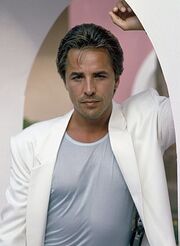
Don Johnson became something of a style icon following his casting as Sonny Crockett
Miami Vice had a direct influence on the fashion trends of the 1980s. Crockett and Tubbs popularized the pastel T-shirt and linen suit look to the point where today it is often considered to epitomize the clothing styles of the entire decade, despite the fact it actually only remained popular for a few years in the mid-1980s. Later trends established on the show, such as the harsh neon colors of Season 3, were also influential, although their popularity has not enjoyed the same lasting fame as the pastel look. Nevertheless, the styles portrayed in the latter seasons of the show remained popular into the early 1990s.
Don Johnson's "designer stubble" was copied by men across America, even leading to the marketing of a specialized razor (initially called the "Miami Device", before the name was changed for fear of a legal suit) that would leave a very short layer of stubble on a man's face. After Six created "Miami Vice" dinner jackets, Kenneth Cole created Crockett and Tubbs shoes, and Macy's opened a dedicated "Miami Vice" section for young men.
Miami Vice also generated huge interest in other equipment featured on the show. Consumer demand for the Bren Ten pistol Crockett used as his sidearm for the first two seasons became so great that Dornaus & Dixon was unable to meet its orders and went bankrupt in 1986. Sales for the Wellcraft SCARAB 38' KV went up 21% in a single year following the vessel's introduction to the series, and as a result Wellcraft produced a limited run of exact replicas. The 38' KV's "Miami Vice" color scheme was also made available on other boats in their range.
The show had a huge effect on the city of Miami itself. Tourism in the city received a tangible boost as result of the series' popularity, and the renovation work carried out on dilapidated buildings by the production team as part of filming led to something of a renaissance in the South Beach area—other buildings and hotels were restored, contributing to the revitalization of the area in the 1990s and the influx of celebrities and luxury hotels and clubs in the 2000s. Today, the area is a mecca for the rich and famous.
Influence on Television[]
Many subsequent law dramas, such as Homicide: Life on the Street, NYPD Blue and Law & Order, though being markedly different in style and theme from Miami Vice, have followed the show's lead in breaking the genre's mould. Miami Vice has also been directly referenced in American television, with shows such as The Simpsons, Family Guy and Saturday Night Live often spoofing the themes made famous in the series.
In 1984, before the show had even started, NBC produced a television special designed to preview the network's 1984-85 fall schedule, and included in that special was a skit called Miami Nice about a group of older women living in Miami (though the show was actually shot in Los Angeles, not Miami). The skit later evolved into the classic series The Golden Girls, which retained its "Miami Nice" nickname throughout its run of seven seasons.
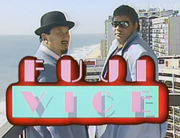
WWE's Fuji Vice skit
In 1985, the WWE's talk-show Tuesday Night Titans aired a skit called Fuji Vice that involved two WWE wrestlers, "Magnificent" Don Muraco and manager Mr. Fuji as two Vice cops who help bring down a drug ring "by accident".
In 1997, Philip Michael Thomas reunited with Don Johnson in the episode "Wild Card" of Johnson's next television series, Nash Bridges, also featuring a guest appearance by Meat Loaf playing a Vice-styled villain. In the scene where Johnson and Thomas first appear on-screen together, a version of the "Miami Vice Theme" can be heard playing in the background. Thomas' character would return in another Nash episode, appropriately titled "Out Of Miami", in the series' final season.
In 2001, the E! network's series The E! True Hollywood Story devoted an episode to Vice, featuring then-new interviews with the show's cast (except for Don Johnson, who was busy working on Nash Bridges at the time; previously-recorded interviews with him were used instead). The episode reviewed the origins of the series, the making of the pilot, Vice's immense popularity in the mid-1980s, and its cancellation in 1989.
In 2014, during the 16th season of the American version of the reality program Big Brother, one of the competitions had a Vice theme called "Miami Lice", with the competitors all dressed in Vice's trademark pastel colors and unconstructed blazers/cotton pants.
The show's influence on television has not just been limited to American Television, but to International television as well. A 1991 feature-length Christmas special of celebrated British sitcom Only Fools and Horses featured the cast traveling to Miami and becoming accidentally involved with the head of a drugs cartel who often dressed in the type of casual clothing made famous by Miami Vice; the episode's name was "Miami Twice", an obvious play on the crime drama's title. More recently, the UK police procedural drama Ashes to Ashes, which is set during the 1980s, featured many elements that clearly paid homage to Vice, including a tense scene in its second season set to the song "In the Air Tonight" by Phil Collins.
In 2012, "In the Air Tonight" also appeared in reference to Miami Vice during season 18, episode 4 of British motoring show Top Gear — the episode began with presenter James May test-driving the electric Fisker Karma car in Miami, which he was shown driving along the iconic South Beach waterfront at night while "In the Air Tonight" played, an obvious homage to Miami Vice.
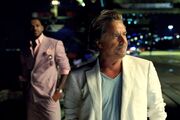
LeBron James and Don Johnson in Nike's 2010 commercial
Several commercials have also played on the show's success. Ridley Scott directed a 1985 Pepsi commercial featuring Don Johnson as James "Sonny" Crockett, alongside Glenn Frey (who appeared on the show as Jimmy Cole in the second season episode "Smuggler's Blues"). The advertisement also used Frey's song "You Belong to the City", which had originally been written especially for Miami Vice. In 2010 the Nike shoe company created an advert featuring NBA star LeBron James (who played for the Miami Heat) that parodied a number of pop culture ideas while he tried to determine what he wanted to do with his life. When he suggests going into acting, the Miami Vice logo suddenly appears, accompanied by Jan Hammer's "Crockett's Theme". In the following brief scene, Don Johnson (dressed as Crockett, complete with white blazer, pastel T-shirt and "designer stubble") gives typically Crockett-esque policing advice to LeBron, who is wearing one of Ricardo "Rico" Tubbs' trademark suits with tie. LeBron's response of, "Should I be writing this down?" is confidently confirmed by Crockett. The Disney series Imagination Movers had a Show within a Show titled Miami Mice. Prior to that, a Goofy Short made for Disney's House of Mouse, "How to Be Groovy, Cool and Fly" had a part in the 1980s segment where Goofy wears Clothes that would look and feel fittingly enough for the series.
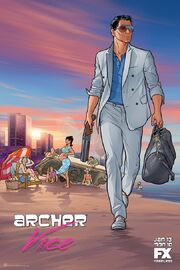
Poster for Archer Vice
For the fifth season of animated comedy Archer, the show was re-branded Archer Vice and its plot shifted to focus on the cast of former spies moving to Florida and forming a cocaine-dealing cartel. As implied by posters advertising the season, it spoofed many of the concepts and clichés associated with Miami Vice. One of the episodes from the fifth season, "Smuggler's Blues", also shared it's name with an episode of Miami Vice.
Influence on Film[]
Although sometimes heavily disputed by their producers, movies such as To Live and Die in L.A. (featuring Debra Feuer, John Pankow, Dean Stockwell and John Turturro), Bad Boys (featuring Kim Coates, Will Knickerbocker, Marc Macaulay and Julio Oscar Mechoso) and Bad Boys 2 borrowed heavily from the concept of Miami Vice, featuring two undercover cops going to extreme lengths to catch their target; Michael Mann even brought an unsuccessful lawsuit against the producers of To Live and Die in L.A., alleging that it plagiarised the television series' concept. The Bad Boys films also highlight the stylish, glitzy yet ultimately seedy atmosphere of Miami's underworld that Vice focused on.
Mann's own film from the mid-1980s, Manhunter, is stylistically very similar to the television series, and features a large number of Miami Vice guest stars amongst its cast, including Garcelle Beauvais, Bill Cwikowski, Chris Elliott, Dennis Farina, Kim Griest, Michele Shay, Bill Smitrovich and Jim Zubiena, as well as Miami Vice regular Michael Talbott, although his single scene was deleted from the theatrical cut of the film. The movie also features music by The Reds and Red 7, bands that contributed songs to Miami Vice, while the film's opening credits utilize the exact same font and layout as the show.
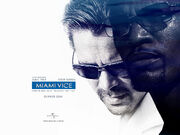
Miami Vice film poster
In 2005, more than 20 years after Miami Vice first aired on television screens, Michael Mann returned to the franchise with the Miami Vice film adaptation, starring Jamie Foxx and Colin Farrell. Released on July 28, 2006, the movie took the characters and settings of the original series and updated them to the 21st century. While the film intentionally tried to distance itself from the show that spawned it, several references are still included, most notably the heavy inclusion of contemporary music and the plot elements (and even some dialogue) taken directly from the episode "Smuggler's Blues".
The technique of removing all background sounds from an important scene and replacing them with a music track, pioneered in the famous "In the Air Tonight" sequence from the Vice pilot episode "Brother's Keeper", has also been heavily mimicked, and is especially prevalent in Michael Mann's movies (it can be seen in his films Manhunter, The Last Of The Mohicans, Heat, The Insider, Collateral, Miami Vice and Public Enemies). The style has also been copied, to a lesser degree, in television shows.
Grand Theft Auto: Vice City[]
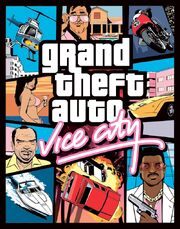
Grand Theft Auto: Vice City. The Miami Vice influence is obvious even from the game's cover art.
Possibly the greatest homages to Miami Vice are the video games Grand Theft Auto: Vice City (2002) and its prequel Grand Theft Auto: Vice City Stories (2006), which, aside from the broad-ranging similarities to the show (heavy inclusion of 80s music -- including new wave, glam metal and synthesizer pop -- dealings with organized crime, drug trafficking, stylized cars, prostitution, pastel clothes etc.), include several direct references to the television series, not least of all the use of the word "Vice" in their titles. Perhaps the most prominent and direct homage occurs when the player achieves a three-star wanted level or higher; along with traditional police squad cars, the player will find themselves being pursued by an unmarked police-issue "Cheetah", a car modelled after the 1986 Ferrari Testarossa, driven by two unnamed, casually dressed undercover cops, one Caucasian and one African-American. Furthermore, the Cheetah they drive is often coloured white, and features the tan leather interior from the car used on show, not found on the games' regular Cheetahs.
Another direct link to Miami Vice is the inclusion of "Crockett's Theme" on Vice City's in-game radio station Emotion 98.3. Several other popular songs that were used in Miami Vice also appear, including "Self Control" by Laura Branigan, "Turn Up the Radio" by Autograph, "Missing You" by John Waite, "Relax" by Frankie Goes to Hollywood, "I Want to Know What Love Is" by Foreigner and "In the Air Tonight" by Phil Collins, while the games additionally feature music from the likes of Afrika Bambaataa & Soulsonic Force, Run-D.M.C., Wang Chung, INXS, Bryan Adams, The Fixx, Lionel Richie, The Pointer Sisters, Iron Maiden, Kate Bush, Mr. Mister, Corey Hart, The Alan Parsons Project, Pat Benatar, Genesis, Ted Nugent, Ratt, Teddy Pendergrass, Depeche Mode, Howard Jones, The Cure and the Pretenders, all of whom had songs appear in the show. The musical similarities extend beyond the game's fictional radio stations to its background score -- many cutscenes and the end credits feature ambient, synth-heavy tracks very much in the style of Jan Hammer, while the Vice City intro theme is comparable to his "Miami Vice Theme".

The screen capture from "Bought and Paid For" (top), and as it appears during the introduction to Vice City (bottom)
Other references in the game are decidedly more subtle. For example, during the opening credits sequence, one of the stylized images that appears framing the in-game footage is actually a screenshot from the second season episode "Bought and Paid For", showing Nico Arroyo's Lamborghini Countach being chased by Crockett's Ferrari Daytona. Two of the in-game street gangs, the Cubans and the Haitians, wear the same clothing as two prominent extras from a scene in "Brother's Keeper", specifically the scene where Tubbs first arrives at Miami airport. There are also small green "tiki statues" hidden around Vice City that can be collected by the player for a monetary reward; these statues are shown to be hollow and packed with cocaine, a reference to the episode "Milk Run".
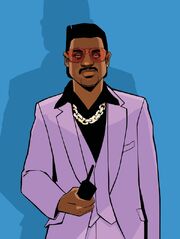
Philip Michael Thomas' Vice City character, Lance Vance.
The two Vice City games feature an extensive cast of well-known Hollywood actors voicing their characters, akin to the famously large number of guest stars featured in the television show. Most notable of these is Lance Vance, one of the primary characters in both games, who is voiced by none other than Philip Michael Thomas (Tubbs). Coincidentally, Vance's goal for much of the first game is to avenge the death of his brother in a drug deal gone wrong, just like Tubbs in the pilot episode of the series. Another noteworthy appearance is by Phil Collins, as himself, in Vice City Stories, which even includes him "performing" a live rendition of his hit "In the Air Tonight" (actually taken from his No Ticket Required video) at an in-game concert. Vice City Stories additionally features interactions with a corrupt undercover law enforcement officer who dresses in a white suit, loafers and a pastel pink t-shirt, mimicking one of Crockett's famous season 1-2 looks.
Many vehicles in the city are modelled after vehicles from the TV series, including the "Squalo" (Crockett's first speedboat), the "Stinger" (Crockett's Daytona), the "Marquis" (the St. Vitus Dance yacht) and the "Infernus" (a Lamborghini Countach, featured in "Golden Triangle (Part II)" and "Bought and Paid For"). Several weapons associated with the show also appear, including a Katana (featured in "Bushido"), the "Stubby Shotgun" (the custom shortened pump-action shotgun Tubbs used from season 2 onwards), The Molotov Cocktail (featured in "Line of Fire") and the MAC-10 (featured prominently in "Evan", among other episodes).